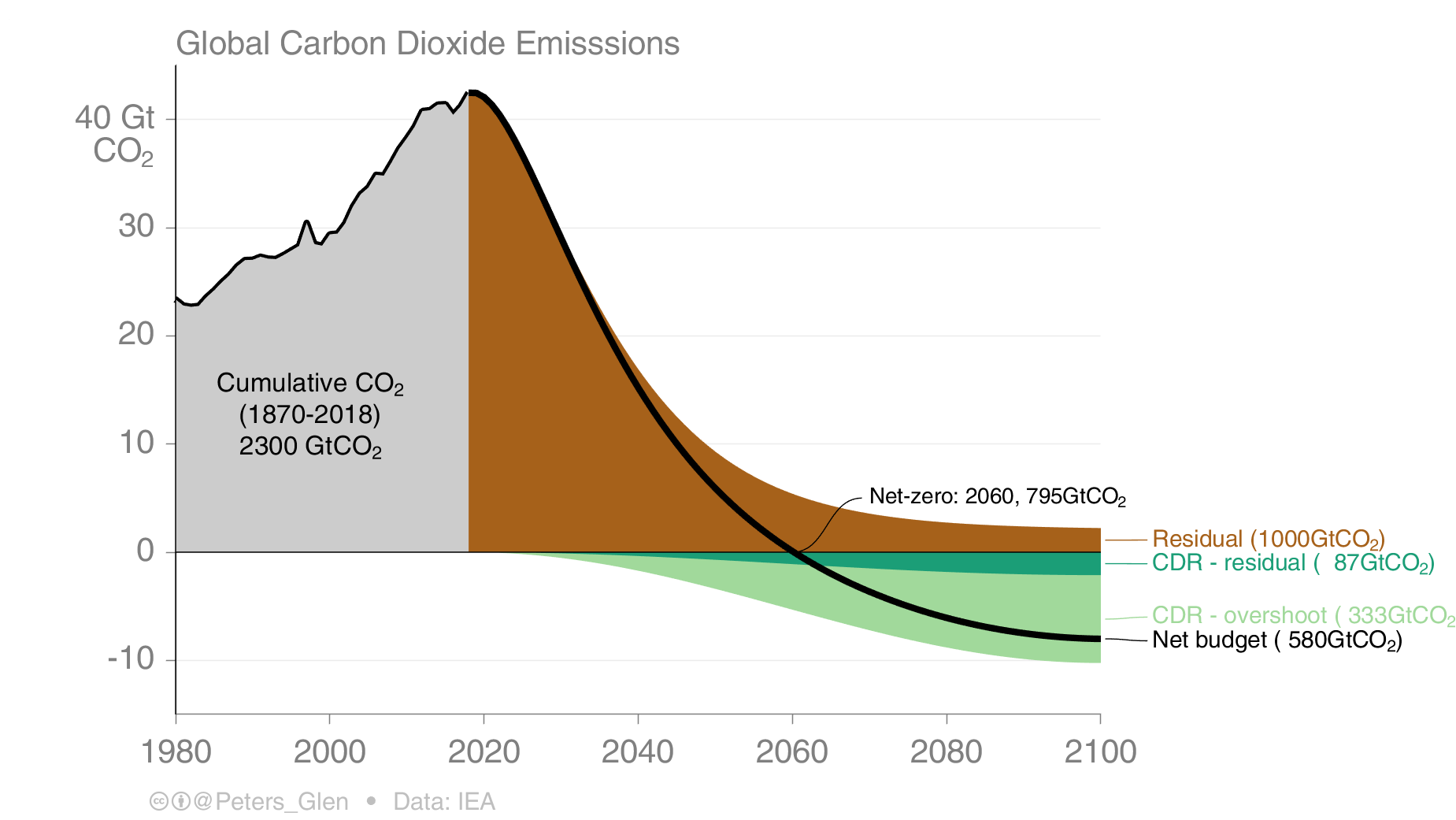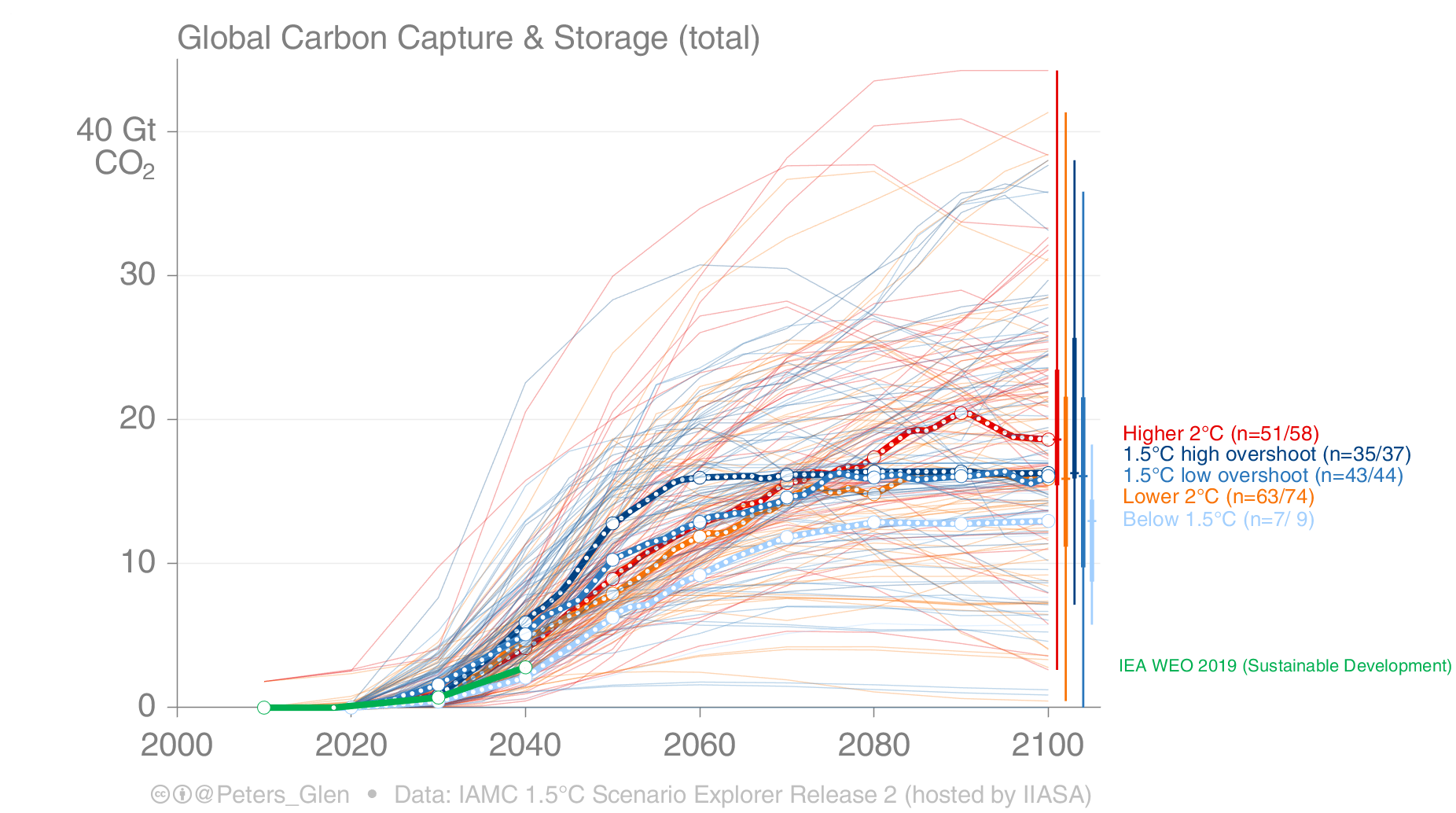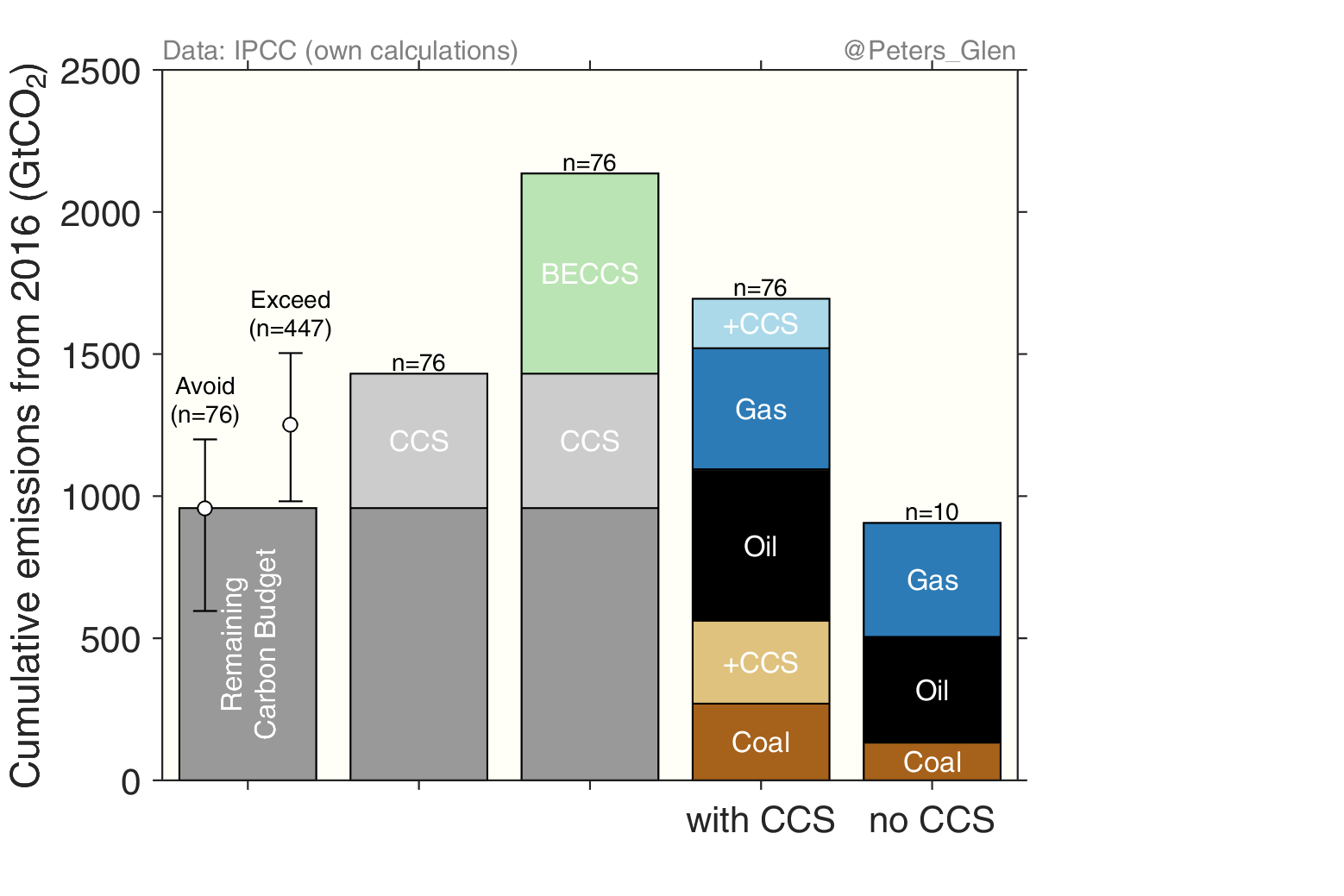Foto: Victor Garcia / Unsplash
Carbon Capture and Storage is necessary to keep global warming below 2°C
Scenarios indicate that Carbon Capture and Storage (CCS) is critical to meet the Paris Agreement’s goal of limiting global warming to ‘well below 2°C’. But, at what scale?
Achieving the Paris Agreement’s goal of limiting global warming to ‘well below 2°C above preindustrial levels and pursuing efforts to limit the temperature increase to 1.5°C above pre-industrial levels’ necessitates rapid reductions in greenhouse gas emissions.
There are now hundreds of emission scenarios showing different evolutions of the energy system consistent with the goals of the Paris Agreement. CCS plays a crucial role in nearly all these emission scenarios.
There is a physical reason why CCS is crucial. CO2 emissions have a cumulative effect on the climate, and therefore CO2 emissions must be net-zero to stop temperatures from increasing further. CCS helps achieve net-zero emissions in two ways:
- To help reduce direct emissions from the burning of fossil fuels or from industrial processes, and
- To help create negative emissions, such as in combination with bioenergy (BECCS), direct air capture, or other technologies to remove CO2 from the atmosphere.
Nearly all emissions scenarios use CCS in both these ways, and sometimes at a troubling scale.
The following figure highlights this.

CCS is used to help reduce emissions from fossil fuel use, which happens in addition to conventional mitigation, such as consuming less energy, deploying solar, or using electric vehicles, But, most scenarios are not able to get fossil emissions completely to zero, or find it too expensive, and end with ‘residual emissions’ (brown in the figure above).
To get to net-zero emissions, the residual emissions must be counteracted by CO2 removal to achieve net zero emissions (dark green). Most models do this with afforestation or bioenergy with CCS (BECCS). Non-CO2 greenhouse gas emissions (such as methane) add to the residual emissions (not shown).
Further CO2 removal (light green), are used to bring temperatures down after peaking. The temperature is a maximum when the net emissions reach zero (black line), but then the temperature declines with net negative emissions to bring the temperature down from its peak to safer levels by 2100.
Can carbon capture and storage be avoided?
Many have critiqued the scale of CCS used in emissions scenarios. Can CCS be avoided?
There are at least some scenarios that can meet the Paris goals without CCS. The existence of scenarios without CCS doesn’t mean CCS is not useful in a mitigation portfolio, as CCS has certain characteristics that makes it complementary to other technologies.
There are three fundamental reasons why CCS may be necessary, whether we love it or hate it.
First, it may be impossible to get emissions to net-zero fast enough without using CCS to eliminate direct emissions or in CO2 removal.
Second, competitively priced technologies do not exist, and may never exist, to reduce emissions to zero in some hard-to-mitigate sectors (such as steel, cement, long-distance shipping, and aviation).
Third, it may simply be cheaper to reduce emissions in some sectors with either CCS or CO2 removal.
Without CCS used both to limit direct fossil fuel emissions or for CO2 removal, the scenario literature suggest it becomes nearly impossible to reduce CO2 emissions fast enough to keep global warming ‘well below 2°C’.
The scale of CCS needed is substantial
The figure below shows the deployment of CCS in scenarios consistent with 1.5°C and 2°C global warming assessed in the IPCC Special Report on Global Warming of 1.5°C and in the IEA World Energy Outlook (2019) Sustainable Development Scenario (green).
The figure shows that CCS is used at scale and needed at all temperature levels, with very little difference between 1.5°C and 2°C scenarios.

The scale of CCS required is substantial in almost all scenarios. Many scenarios have around 10 billion tonnes CO2 per year by 2050. To put this scale in perspective, a typical average sized CCS facility may remove 1 million tonnes of CO2 per year:
- If one average CCS facility was built every week through to 2050, that would lead to around 1.5 billion tonnes CO2 per year CCS
- If one average CCS facility was built every day through to 2050, that would lead to around 11 billion tonnes CO2 per year CCS
Some scenarios have 20 to 30 billion tonnes CO2 per year in 2050. The IEA has one of the lowest levels of CCS, in their case around 3 billion tonnes CO2 per year, by 2040 when their scenario ends.
OECD and Asia generally have the highest level of CCS deployment in these scenarios, but Latin America and the Middle East and Africa have significant deployment in some models. Models suggest Europe may have as many as 1,000 CCS facilities (~1 billion tonnes CO2 per year) by 2050.
Of the models used to compute emissions scenarios, many are not able to meet the ‘well below 2°C’ goal if the use of CCS is eliminated. In scenarios that can still achieve the 2°C goal without CCS, have around twice the mitigation cost as the equivalent scenarios that do not use CCS.
The mind-boggling scale of CCS in some scenarios does not mean we should give up on CCS as we are unlikely to meet that scale in reality. Rather, it indicates an important function that CCS plays in scenarios, and therefor how it may be important for meeting ambitious climate targets.
The speed of fossil fuel phase out
The deployment of CCS happens in parallel to a reduction in fossil fuel use, improvements in energy efficiency, and the rapid scale-up of other low-carbon technologies, such as solar, wind, and electric vehicles.
Scenarios that don’t deploy CCS, or have lower levels of CCS, show even steeper declines in fossil fuel use, more rapid growth in non-fossil energy sources (e.g., renewables and nuclear), increased dependence on large-scale forestry activities for CO2 removal, and higher mitigation costs.
This means that – everything else being the same and ignoring possible lock-in effects – the large-scale deployment of CCS allows a slightly slower decline in the use of fossil fuels, particularly coal and gas, and oil if it is offset by large-scale CO2 removal.
CCS may also be the only mitigation option available in some sectors, such as cement and steel production.
Based on scenarios in the IPCC Fifth Assessment Report (AR5 ), scenarios with CCS allow about twice the amount of fossil fuel use compared to scenarios without CCS (last two bars in the figure below). This only holds if CCS is deployed, at the scales mentioned above, to fossil fuels and industry (grey) and bioenergy (green) for CO2 removal.

Still, CCS represents no silver bullet. It is only part of a broader mitigation portfolio. In all scenarios, CCS operates in combination with other mitigation measures, and not as a substitute for other mitigation measures.
The need for government support
The models that are used to compute mitigation scenarios mostly implement the Paris Agreement’s goal in a cost optimal manner. This implies high and uniform global carbon prices, which encourages early deployment of CCS.
In reality, policy is implemented in a more fragmented way, with countries moving and different speeds and ambition lagging behind where it ought to be.
This reality is likely to lead to lower and more uncertain climate policies and effective carbon prices, which may not be sufficient to encourage the development and deployment of CCS.
In this real-world context, other policy mechanisms are needed to support and encourage the development and deployment of CCS. A more bottom up approach might be needed to encourage CCS, with different niche applications matching to regional context with global cooperation to ensure learning.
To ensure that CCS is deployed at scale to make a meaningful contribution to the Paris Agreement’s ‘well below 2°C’ goal, it is likely innovative government support is necessary to operate in parallel with conventional climate policies.
Further Reading
For further details and analysis, read our report on The Role of Carbon Capture and Storage in the Mitigation of Climate Change, written for the Royal Norwegian Ministry of Petroleum and Energy (OED).
